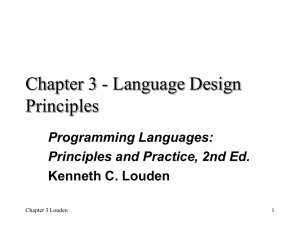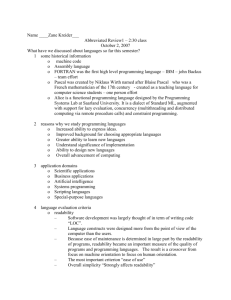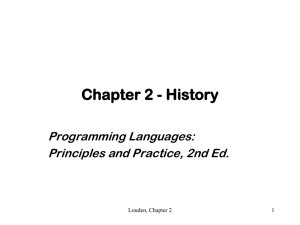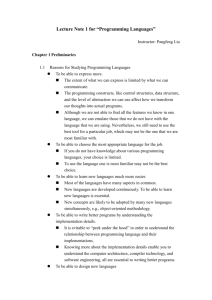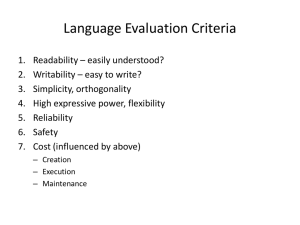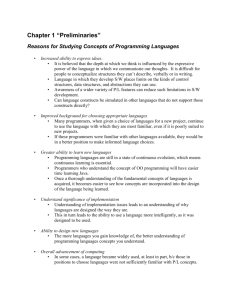Chapter 3 - Language Design Principles
advertisement
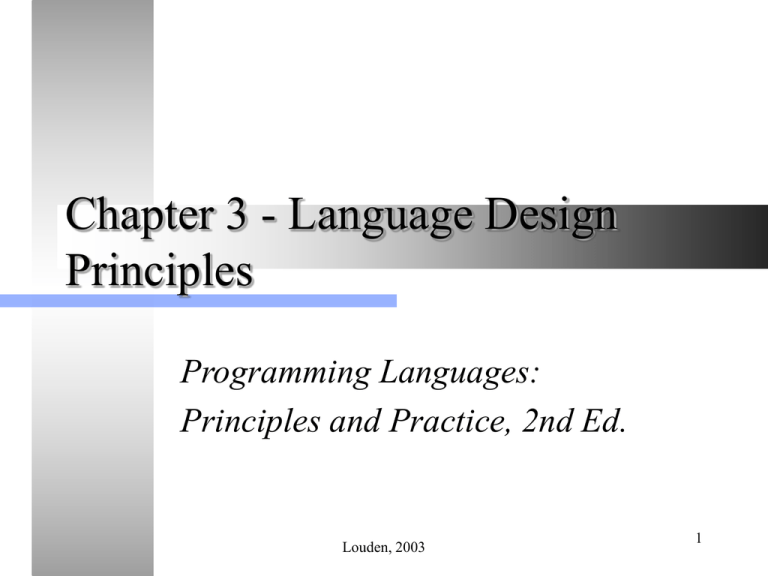
Chapter 3 - Language Design
Principles
Programming Languages:
Principles and Practice, 2nd Ed.
Louden, 2003
1
The language design problem
Language design is difficult, and
success is hard to predict:
– Pascal a success, Modula-2 a failure
– Algol60 a success, Algol68 a failure
– FORTRAN a success, PL/I a failure
Nevertheless, there have been some
basic goals or principles that have
been important over the years, and
that can contribute to success.
Chapter 3
K. Louden, Programming Languages
2
Efficiency
The “first” goal (FORTRAN):
execution efficiency.
Still an important goal in some
settings (C++, C).
Many other criteria can be
interpreted from the point of view of
efficiency:
– programming efficiency: writability,
reliability (security).
– maintenance efficiency: readability.
Chapter 3
K. Louden, Programming Languages
3
Features that aid efficiency of
execution
Static data types allow efficient
allocation and access.
Manual memory management avoids
overhead of “garbage collection”.
Simple semantics allow for simple
structure of running programs
(simple environments - Chapter 8).
Chapter 3
K. Louden, Programming Languages
4
Features that aid other design
goals (note efficiency conflicts):
Writability, expressiveness: no static
data types (variables can hold
anything, no need for type
declarations).
Reliability, writability, readability:
automatic memory management (no
need for pointers).
Expressiveness, writability,
readability: more complex semantics,
allowing greater abstraction.
Chapter 3
K. Louden, Programming Languages
5
Internal consistency of a
language design: Regularity
Regularity is a measure of how well a
language integrates its features, so that
there are no unusual restrictions,
interactions, or behavior.
Regularity issues can often be placed in
subcategories:
– Generality: are constructs general enough? (Or
too general?)
– Orthogonality: are there strange interactions?
– Uniformity: Do similar things look the same, and
do different things look different?
Chapter 3
K. Louden, Programming Languages
6
Regularity examples from C
Functions are not general: there are
no local functions (simplicity of
environment).
Declarations are not uniform: data
declarations must be followed by a
semicolon, function declarations
must not.
Parameters are not orthogonal with
data type: arrays are references,
other parameters are copies.
Chapter 3
K. Louden, Programming Languages
7
What about Java?
Are function declarations non-general?
– There are no functions, so a non-issue. (Well,
what about static methods?)
Are class declarations non-general?
– No multiple inheritance (but there is a reason:
complexity of environment).
– Java has a good replacement: interface
inheritance.
Do declarations require semicolons?
– Local variables do, but is that an issue? (Not
really - they look like statements.)
Chapter 3
K. Louden, Programming Languages
8
Java regularity, continued
Are some parameters references, others
not?
– Yes: objects are references, simple data are
copies.
– This is a result of the non-uniformity of data in
Java, in which not every piece of data is an
object.
– The reason is efficiency: simple data have fast
access.
What is the worst non-regularity in Java?
– My vote: arrays. But there are excuses.
Chapter 3
K. Louden, Programming Languages
9
Other design principles
Simplicity: make things as simple as
possible, but not simpler. (Pascal, C)
Expressiveness: make it possible to
express conceptual abstractions directly
and simply. (Scheme)
Extensibility: allow the programmer to
extend the language in various ways.
(Scheme, C++)
Security: programs cannot do unexpected
damage. (Java)
Chapter 3
K. Louden, Programming Languages
10
Other design principles (cont.)
Preciseness: having a definition that can
answer programmers and implementors
questions. (Most languages today, but only
one has a mathematical definition: ML)
Machine-independence: should run the same
on any machine. (Java)
Consistent with accepted notations. (Most
languages today, but not Smalltalk & Perl)
Restrictability: a programmer can program
effectively in a subset of the full language.
(C++: avoids runtime penalties)
Chapter 3
K. Louden, Programming Languages
11
C++ case study
Thanks to Bjarne Stroustrup, C++ is
not only a great success story, but
also the best-documented language
development effort in history:
– 1997: The C++ Programming Language,
3rd Edition (Addison-Wesley).
– 1994: The Design and Evolution of C++
(Addison-Wesley).
– 1993: A History of C++ 1979-1991,
SIGPLAN Notices 28(3).
Chapter 3
K. Louden, Programming Languages
12
Major C++ design goals
OO features: class, inheritance
Strong type checking for better
compile-time debugging
Efficient execution
Portable
Easy to implement
Good interfaces with other tools
Chapter 3
K. Louden, Programming Languages
13
Supplemental C++ design goals
C compatibility (but not an absolute goal:
no gratuitous incompatibilities)
Incremental development based on
experience.
No runtime penalty for unused features.
Multiparadigm
Stronger type checking than C
Learnable in stages
Compatibility with other languages and
systems
Chapter 3
K. Louden, Programming Languages
14
C++ design errors
Too big?
– C++ programs can be hard to
understand and debug
– Not easy to implement
– Defended by Stroustrup: multiparadigm
features are worthwhile
No standard library until late (and
even then lacking major features)
– Stroustrup agrees this has been a major
problem
Chapter 3
K. Louden, Programming Languages
15
DUPLICATE MATERIAL?
Chapter 3
K. Louden, Programming Languages
16
What makes a good language?
1.
2.
3.
It is almost impossible to get to CS types to agree on what is most
important.
Important features of the language include:
Readability - important because ease of maintenance is greatly influenced
by readability Restricting identifiers to short length affects readability.
Writability Trade-off: readability and writability
Clarity, simplicity and unity of Language concept
–
–
–
–
–
–
–
Chapter 3
Language is an aid to the programmer
Conceptual integrity: Minimum number of different concepts - rules simple
Sometimes programmer who must use a large language have tendency to learn a
subset of of the language and then ignore its other features. This is used to
justify the large number of language components. But readability problems will
occur as someone must read in another's subset of the language.
Having more than one way to accomplish the same thing (multiplicity) is a
detriment to simplicity. (In C, c= c+1; c++, ++c, c+=1 all do the same thing)
Operator overloading (single operator has more than one meaning) is another
problem. (+: integer add, float add, set addition, etc)
Sometimes statements are TOO simple - no complex control structure - and thus
hard to read.
Control Statements. sequence, selection, iteration, recursion.
Data Structures: The presence of adequate facilities for defining data types and
data structures is significant aid to readability.
K. Louden, Programming Languages
17
4.
Orthogonality: a relatively small set of primitive constructs can be combined in a
relatively small number of ways. Every possible combination is legal. For example - in
IBM assembly language there are different instructions for adding memory to register
or register to register (non-orthogonal). In Vax, a single add instruction can have
arbitrary operands.
Closely related to simplicity - the more orthogonal, the fewer rules to remember.
For examples of non-orthogonality consider C++:
We can convert from integer to float by simply assigning a float to an integer, but not
vice versa.
We can use a derived class instance in place of a parent class instance, but not vice
versa.
A switch statement works with integers, characters, or enumerated types, but not
doubles.
Arrays are pass by reference while integers are pass by value.
Too much orthogonality can also be a problem - sometimes get unnatural or
extremely complex results. When any combination is legal, errors in writing programs
can go undetected. Can accidentally use unknown features.
Functional languages (so named as computations are made primarily by applying
functions to given parameters - Lisp, Prolog) are completely orthogonal and very
simple as they have a single control construct - the function.
In contrast, an imperative language (like C++) have computations specified by
variables and assignment statements.
Chapter 3
K. Louden, Programming Languages
18
5. Naturalness for Application - reason for proliferation of languages
Ease of use
readable
Cryptic programs may be easy to write - but impossible to read
What makes a program difficult to read?
Form of Special Words
begin-end or {} suffer in that all constructs are terminated the
same way.
Also, if special words can also be used as variable names, the
result can be very confusing.
Different meanings LOOK different
In Snobol a single blank can alter the statements meaning \
X_Y_=_Z vs XY_=_Z
The latter is assignment of Z to XY. The former means the pattern
Y is looked for in X and, if found, is replaced in X by Z. \ X = `A
GOOD EXAMPLE' Y = `GOOD' Z = 'BAD' XY = Z XY = 'BAD'
(variable XY is assigned the string) X Y = Z X = 'A BAD EXAMPLE'
Meaning of statement is obvious from form. Grep in Unix can be
deciphered only through prior knowledge. Even the name of grep
is hard to remember. It is named because of g/regular
expression/p. Beginning g means ``global'' and trailing p means
print.
Reflects logical structure of program
Will be easier to write - won't have to redesign logic to code
Chapter 3
K. Louden, Programming Languages
19
6. Support for Abstraction (Extension)
Abstraction means: complicated structures can be stated in simple ways
by ignoring many of the details. The goal is to allow data structures, types,
and operations to be defined and maintained as self contained
abstractions the programmer may use them in other parts of program
knowing only abstract properties
Procedures and functions are starts in this direction.
User defined types are a start
Black Box vs. Clear Box
7. Ease of program verification - External Support
Formal (proofs of correctness) OR informal (testing)
Debugging aids
Test Facilities
Structure of Language - Proofs
8. Programming environment
implementation
documentation
editors
testing packages
Chapter 3
K. Louden, Programming Languages
20
9. Portability (transportability)
10. Reliability - affected by readability and writability
Type Checking: testing for type compatibility. Important in reliability in that run time
checking is expensive. If cannot be done at compile time, user may suspend with
dangerous results.
Trade-off: reliability and cost of execution
Exception Handling: the ability for a program to intercept run-time errors, take
corrective measures, and continue is a great aid to reliability.
Aliasing: two distinct referencing methods or names for the same cell. May be too
dangerous to justify.
11. Cost
training programmers to use the language.
writing/testing: programmer time is very important now
translation: not very important except in an educational environment
execution: may not be important in some applications
cost of language implementation system
cost of poor reliability
maintenance - the largest cost if used several years
includes: errors in original; changes caused by hardware or OS changes;
extensions and enhancements to original product Cost depends on a number of
language features, but primarily on readability.
Chapter 3
K. Louden, Programming Languages
21

